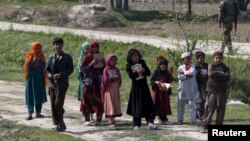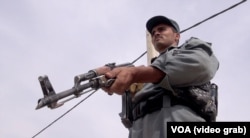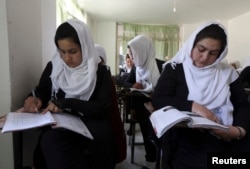A new report finds state security forces in Afghanistan are increasingly using schools in Taliban-held areas for combat missions, threatening children’s lives and education.
Human Rights Watch in its report released Wednesday has demanded the government take immediate steps to stop putting schools at the center of the fighting and protect gains the Afghan education sector has made with the help of massive international investment in the post-Taliban era.
Focus on northern Baghlan province
The report principally focused on activities Afghan security forces have conducted in the northern Baghlan province, which has seen intense fighting over the past year in and around its capital city of Pul-e-Khumri, said Patricia Gossman, senior Afghanistan researcher at the New York-based organization.
She said the number of instances in which Afghan military personnel occupied schools for combat activities was “quite shocking.”
“Afghan children’s education is at risk not just from the Taliban, but also from government forces that occupy their schools. Children are being put in harm’s way by the very Afghan forces mandated to protect them,” she noted, adding Taliban insurgents have also used schools in Baghlan for anti-government attacks.
Destruction of Swedish-financed school
The report says “Taliban forces occupied a Swedish government-financed school in Omar Khail village soon after it opened its doors in 2015, to 350 boys and girls. Pleas by village elders to leave were rejected. In early 2016, government forces attacked the Taliban forces in the school with gunfire and mortar rounds. The Taliban fled, but the school compound was left in ruins.”
Gossman said the findings are based on interviews with more than 20 school principals, teachers, and administrators, as well as local families affected by the conflict.
“We had situations where even tent schools were being used by the military. And obviously, the other concern is that this has a disproportionate affect on girls’ education because if you have got a bunch of armed men in a school, families are going to be particularly reluctant to send their girls to schools,” she told VOA.
Afghan government challenges report
Afghan Defense Ministry spokesman Dawlat Waziri rejected the report, saying the government’s own investigations have not found any such violations.
“However, we do not rule out the possibility of use of schools by security forces for an hour, or a couple of days in instances when these facilities were closed for vacations, or in areas where operations were underway against insurgents,” Waziri told VOA.
Expansion of school system in Afghanistan
Education is one of few success stories in Afghanistan since the demise of the Taliban rule in 2001, when less than a million children, all of them boys, were attending school. According to the Afghan Ministry of Education, the number has since risen to 9.5-million and girls make up around 40 percent of students.
“Even though the conflict is of course of deep concern [and] it has intensified, it is of the outmost importance to protect these facilities to protect that investment in Afghanistan’s future and for the Afghan government to get its soldiers out of the schools, Gossman said. "I think that is what the message donors need to send now and at the upcoming conference on Afghanistan, which will take place in October [in Brussels] we are hoping to see the donors make that very clear to the Afghan government.”
Overall military situation in Baghlan
The security situation in Baghlan continues to deteriorate, where the Taliban has made significant advances in a number of areas and recently captured a key district just a few kilometers away from the provincial capital.
"Prospects for improved security in Baghlan in the second half of 2016 remain as bleak as they were during the first half, especially after the fall of Dahna-ye Ghori three days ago. This was the first district to fall into Taliban hands in Baghlan province since 2001," according to the Kabul-based independent Afghanistan Analysts Network.











